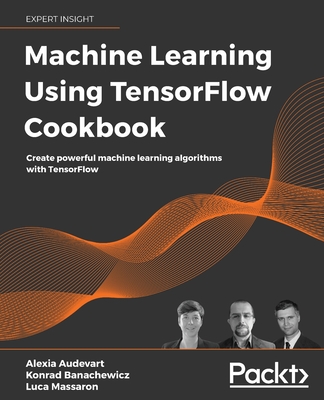Python Deep Learning Cookbook: Over 75 practical recipes on neural network modeling, reinforcement learning, and transfer learning using Python
Indra den Bakker
- 出版商: Packt Publishing
- 出版日期: 2017-10-27
- 定價: $1,480
- 售價: 6.0 折 $888
- 語言: 英文
- 頁數: 330
- 裝訂: Paperback
- ISBN: 178712519X
- ISBN-13: 9781787125193
-
相關分類:
Python、程式語言、DeepLearning
-
相關翻譯:
Python 深度學習實戰:75個有關神經網絡建模、強化學習與遷移學習的解決方案 (Python Deep Learning Cookbook: Over 75 practical recipes on neural network modeling, reinforcement learning, and transfer learning using Python) (簡中版)
立即出貨 (庫存=1)
買這商品的人也買了...
-
 $1,680Computer Vision: Algorithms and Applications (Hardcover)
$1,680Computer Vision: Algorithms and Applications (Hardcover) -
 $1,550Optimal Control, 3/e (Hardcover)
$1,550Optimal Control, 3/e (Hardcover) -
 精通 Python|運用簡單的套件進行現代運算 (Introducing Python: Modern Computing in Simple Packages)
精通 Python|運用簡單的套件進行現代運算 (Introducing Python: Modern Computing in Simple Packages)$780$616 -
 $250OpenCV 3 計算機視覺 : Python 語言實現, 2/e (Learning OpenCV 3 Computer Vision with Python, 2/e)
$250OpenCV 3 計算機視覺 : Python 語言實現, 2/e (Learning OpenCV 3 Computer Vision with Python, 2/e) -
 $1,617Deep Learning (Hardcover)
$1,617Deep Learning (Hardcover) -
 $2,208Deep Learning with Python: A Hands-on Introduction
$2,208Deep Learning with Python: A Hands-on Introduction -
 Deep Learning|用 Python 進行深度學習的基礎理論實作
Deep Learning|用 Python 進行深度學習的基礎理論實作$580$458 -
 自然語言處理:用人工智慧看懂中文
自然語言處理:用人工智慧看懂中文$690$587 -
 OpenCV + VTK + Visual Studio 影像辨識處理, 2/e
OpenCV + VTK + Visual Studio 影像辨識處理, 2/e$650$507 -
 Python 程式設計的樂趣|範例實作與專題研究的 20堂程式設計課
Python 程式設計的樂趣|範例實作與專題研究的 20堂程式設計課$550$435 -
 $1,558Deep Learning for Computer Vision
$1,558Deep Learning for Computer Vision -
 Natural Language Processing with Python Cookbook: Over 60 recipes to implement text analytics solutions using deep learning principles
Natural Language Processing with Python Cookbook: Over 60 recipes to implement text analytics solutions using deep learning principles$1,690$1,606 -
 Python 網頁程式交易 APP 實作:Web + MySQL + Django
Python 網頁程式交易 APP 實作:Web + MySQL + Django$680$530 -
 $1,280Natural Language Processing with TensorFlow
$1,280Natural Language Processing with TensorFlow -
 $403OpenCV 電腦視覺編程攻略, 3/e
$403OpenCV 電腦視覺編程攻略, 3/e -
 $352文本上的算法 深入淺出自然語言處理
$352文本上的算法 深入淺出自然語言處理 -
 人工智能基礎 (高中版)
人工智能基礎 (高中版)$210$200 -
 最新人工智慧應用:用強化學習快速上手 AI
最新人工智慧應用:用強化學習快速上手 AI$580$493 -
 Python 深度學習實作:Keras 快速上手
Python 深度學習實作:Keras 快速上手$500$390 -
 $280Keras 深度學習實戰
$280Keras 深度學習實戰 -
 白話深度學習與 TensorFlow
白話深度學習與 TensorFlow$480$379 -
 人工智慧高手書:深度學習之識別及最佳化
人工智慧高手書:深度學習之識別及最佳化$780$663 -
 $403圖解深度學習與神經網絡:從張量到 TensorFlow 實現
$403圖解深度學習與神經網絡:從張量到 TensorFlow 實現 -
 $352機器學習:使用 OpenCV 和 Python 進行智能圖像處理 (Machine Learning for OpenCV)
$352機器學習:使用 OpenCV 和 Python 進行智能圖像處理 (Machine Learning for OpenCV) -
 $301scikit-learn 機器學習, 2/e (Mastering Machine Learning with scikit-learn, 2/e)
$301scikit-learn 機器學習, 2/e (Mastering Machine Learning with scikit-learn, 2/e)
相關主題
商品描述
Key Features
- Over 100 recipes on mathematical theory of each deep learning algorithm , its implementation and a bunch of related techniques for using them
- Provides explanation with examples covering deep learning algorithms using popular python frameworks like TensorFlow, Caffe, Keras, Theano
- Your ideal companion to train models involving neural networks problem and tuning it for a completely different problem, and getting impressive results.
Book Description
Deep Learning is revolutionizing a wide range of industries. For many applications, deep learning has proven to outperform humans by making faster and more accurate predictions. This book provides a top-down and bottom-up approach to demonstrate deep learning solutions to real-world problems in different areas. These applications include Computer Vision, Natural Language Processing, Time Series, and Robotics.
The Python Deep Learning Cookbook presents technical solutions to the issues presented, along with a detailed explanation of the solutions. Furthermore, a discussion on corresponding pros and cons of implementing the proposed solution using one of the popular frameworks like TensorFlow, PyTorch, Keras, Caffe or Theano is provided. The main purpose of this book is to provide Python programmers a detailed list of recipes to apply deep learning to common and not-so-common scenarios.
What you will learn
- Select the best Python framework for deep learning to use in case of specific problems/requirements
- Understand the definition of neural network models
- Learn to apply tips and tricks related to neural networks internals, to boost learning performances
- Consolidate machine learning principles and apply them in the deep learning field
- Reuse and adapt Python code snippets to everyday problems
- Evaluate the cost/benefits and performance implication of each discussed solution










